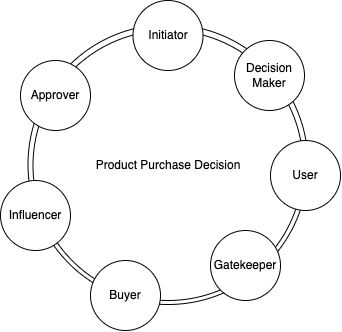For someone who loves to create new products, it was important to learn how to get these into the hands of consumers. After all, how valuable is a product if it is not being used? I know some people who create products but they are never able to get it out in the real world only because they don’t follow a GTM (Go To Market) strategy. They try to recruit friends and family to try it, and when that fizzes out, they just give up on the product and it lies in the heap of finished products that might have been successful if the GTM strategy had been planned and executed.
I keep reminding myself that making a good product is just a small part of the larger goal, which is to make a profitable business. Let’s dive in and see how we can create a GTM strategy framework to help launch your next cool product.
Identify the buying center
B2B products have a bigger sales cycle than consumer products. Every organization has the buying center, which is a group of people who together make the purchase decision. It is important to know what each persona does and map it to every potential client organization. This will help you understand the problems that they face and persuade them towards using your product as a solution to those problems.

Initiator
Person who finds the issue and initiates new requirements within the organization
User
Person who will use the product on a daily basis and feels it will help their day to day work
Gatekeeper
Person who controls the flow of information and might block your product onboarding
Influencer
Person who convinces other people to onboard your product
Decision Maker
Person who gives the final purchase approval for your product
Buyer
Person who has alloted budget and approves the purchase decision
Approver
Person who decides to onboard the product to a large number of people and helps your product scale within the organization
You will have to build a relationship with each of these buyers for a smoother onboarding experience within the organization. How you nurture these relationships will decide if the buying center purchases your product and if they will approve purchase renewal. A big factor will also be how much value the product brings to them. Which brings us to defining the value matrix for the buying center personas. Let’s take HR Payroll software as an example to create a value matrix.
Define value matrix
This caters to the needs of each persona in the buying center and helps you nudge those personas towards buying your product. Each persona might have different problems and motivations to using your product and you should certainly remind them of the value that your product adds to their working lives by the messaging that you design and deliver to these people.
| Personas | Designation / Dept | I want to | So that I | Messaging |
|---|---|---|---|---|
| Initiator | Senior HR Manager | Make the salary payment on time | Can make the employee experience better | Deploy our automated HR Payroll software to improve employee retention. |
| User | HR Executive | Quickly calculate salary for all employees | Can save time and work on other pending tasks | Now sit back, relax and let our HR Payroll software do the hard work for you. |
| Gatekeeper | HR Director | Save my annual budget | Can plan for coming quarters with ease | Monthly pricing available. |
| Influencer | Accounts | Process salaries on time | Am not under pressure every month even if delay is from HR end | Never worry about last minute salary calculations ever again. Let our HR Payroll software do the hard work for you. |
| Decision Maker | COO | Reduce time taken by company to process salaries | Can assign other important tasks | Our software reduces your team’s burden so your team can focus on more important work. |
| Buyer | HR Director | Save time of the team spent in repetitive tasks | HR operations are more productive | Streamline HR operations by using our HR Payroll software |
| Approver | CEO | Make payroll processing efficient across all companies under group company | Can improve efficiency in my group of companies | Let our software lift the weight off your team’s shoulders to make your payroll processing quick, accurate and predictable. |
Test your messaging
Create campaigns on different channels and see what works for your target audience. Optimize your messaging and campaign to see what drives higher conversions. Test, optimize and repeat until you start getting your desired results. Communicate with these users, qualify leads via inside sales to build a scalable sales process.
Your GTM strategy may not be perfect from the start. Give yourself time and patience until you optimize if needed and start seeing results. Your revenue will start flowing in. Your GTM strategy differs based on the product and business model. I work to study the market, competition, user demographics and pricing models when creating any GTM strategy.
Hope this framework helps you to launch and grow your products. Make sure to click on subscribe if you like this post and would like to be notified about new posts!
Read More:
How to Plan for Product Scalability
14 App Retention Strategies that work!
Featured Image by macrovector on Freepik
Leave a Reply